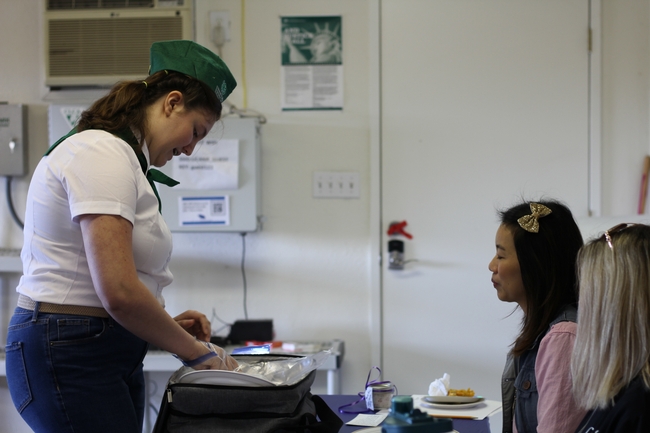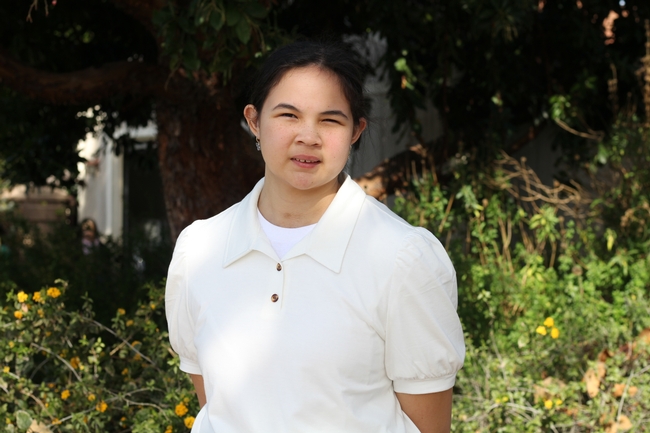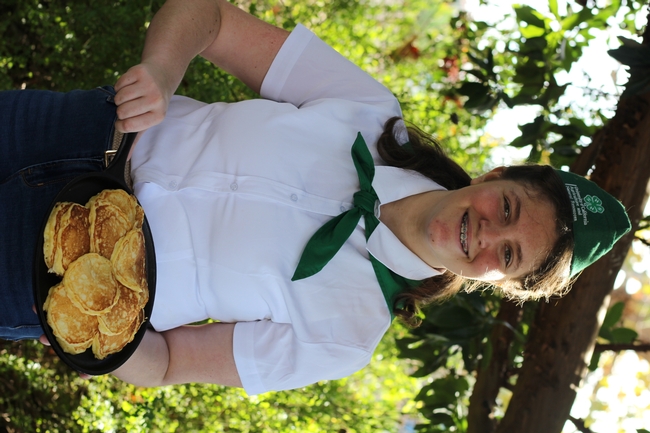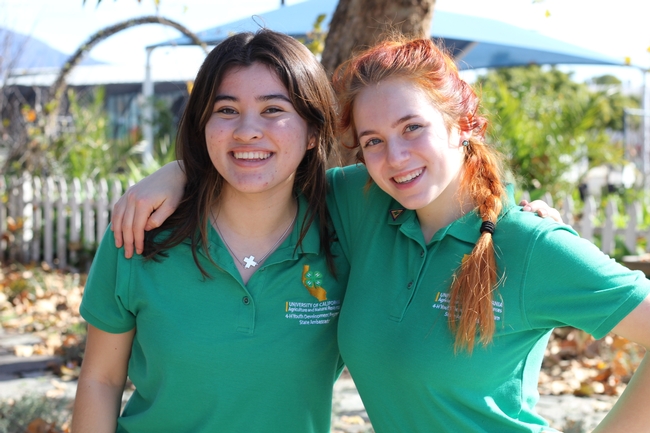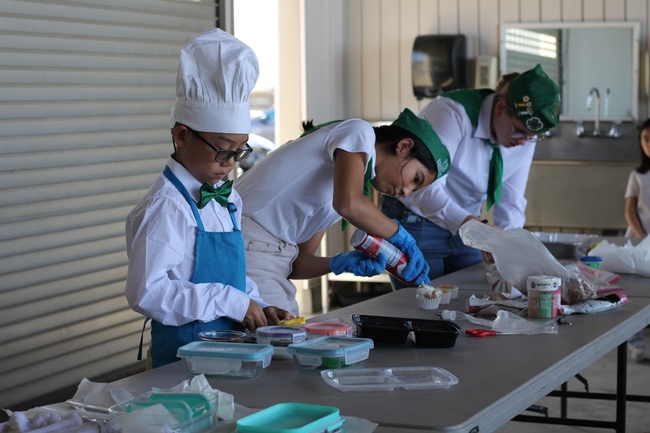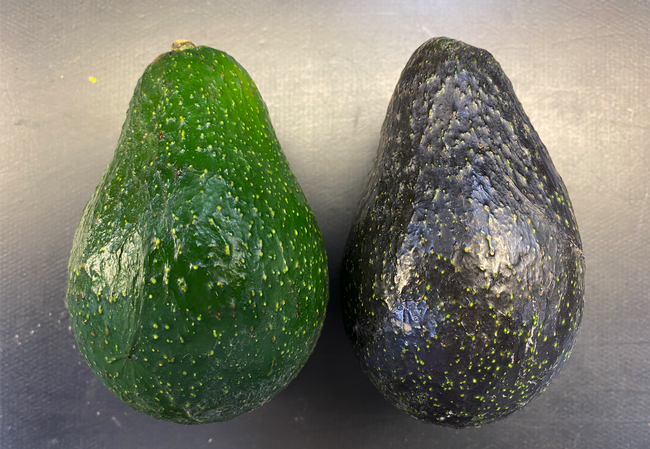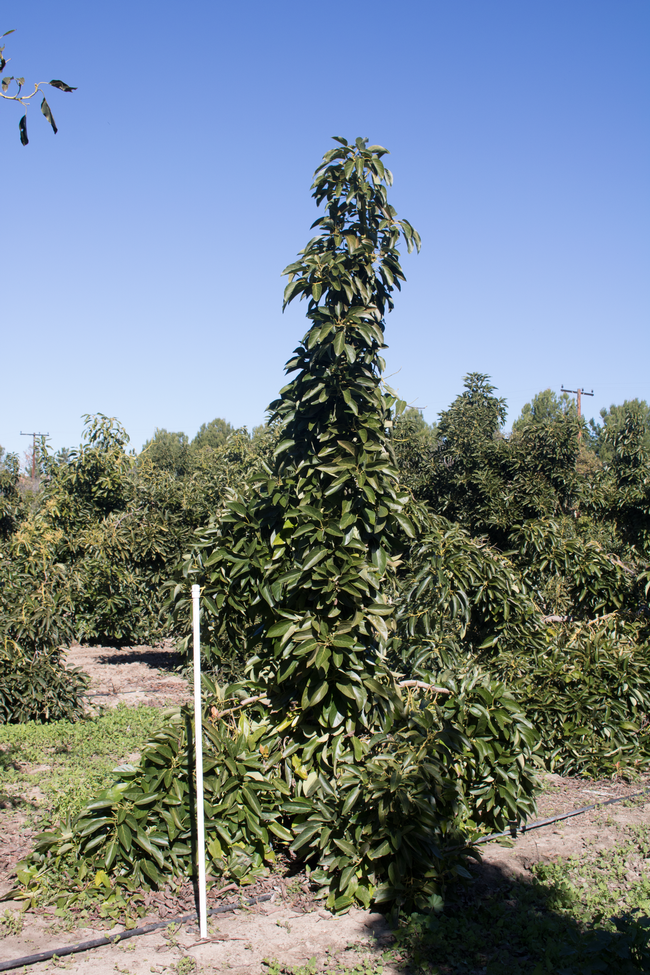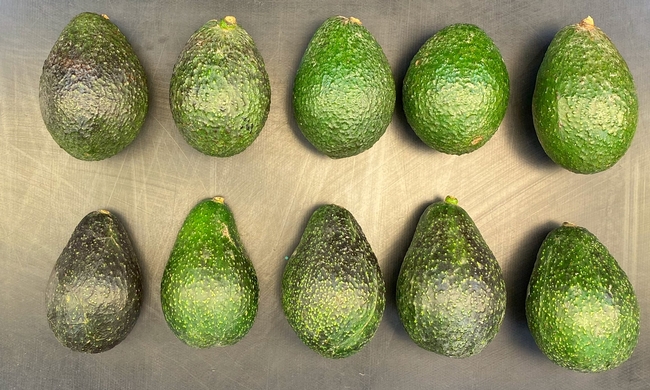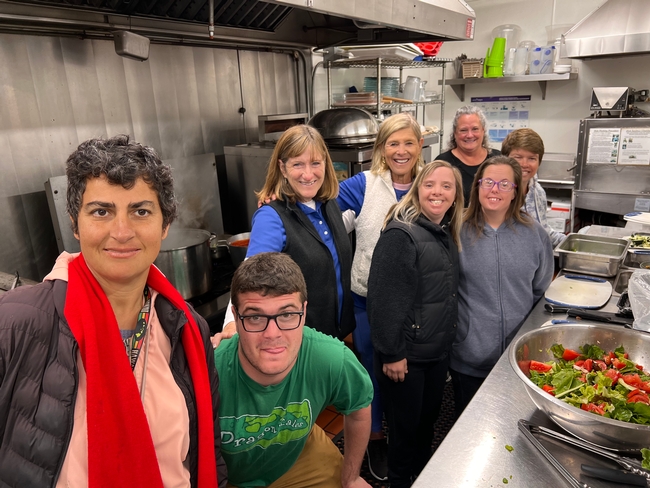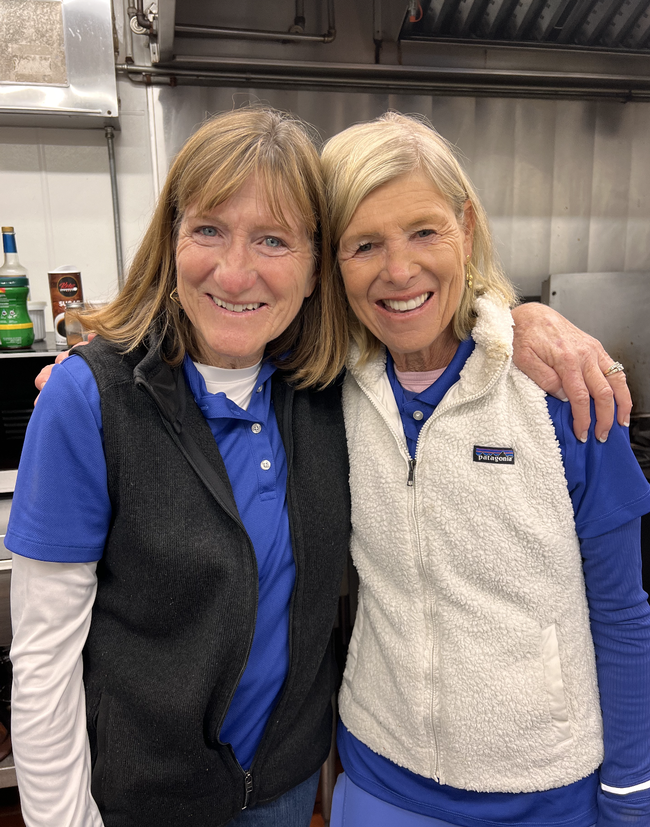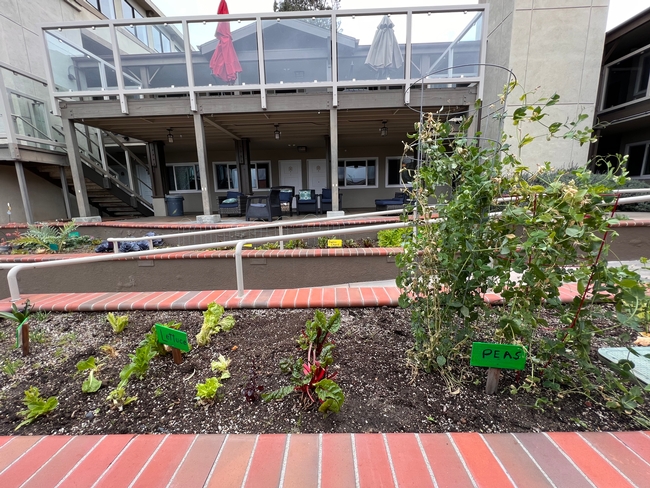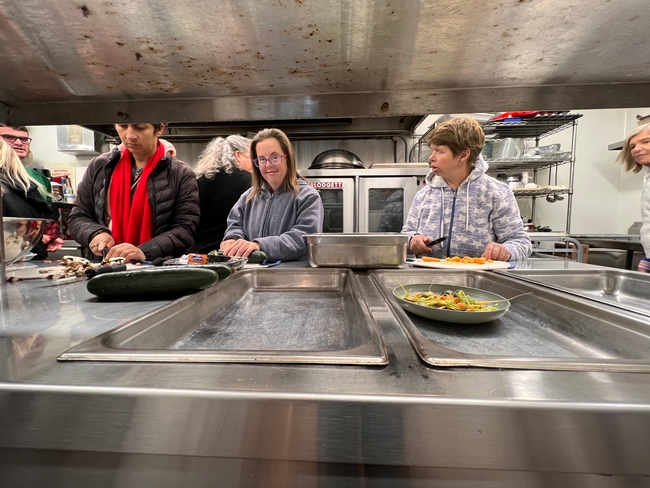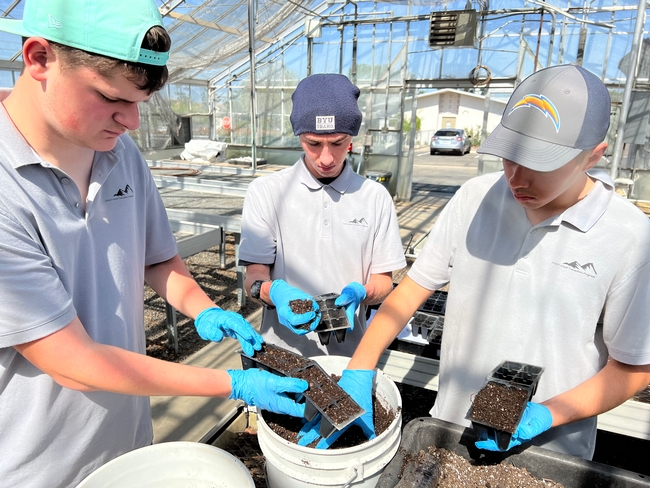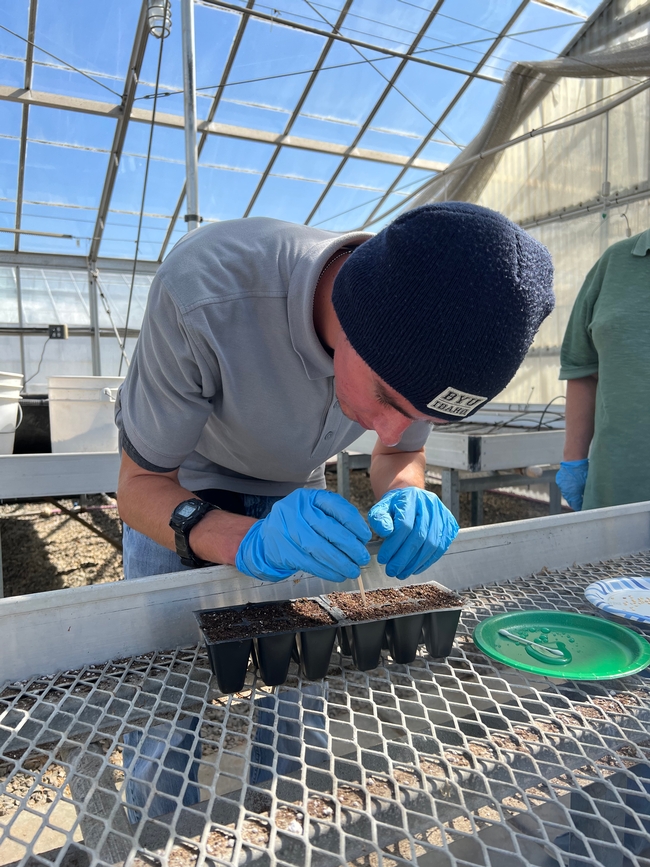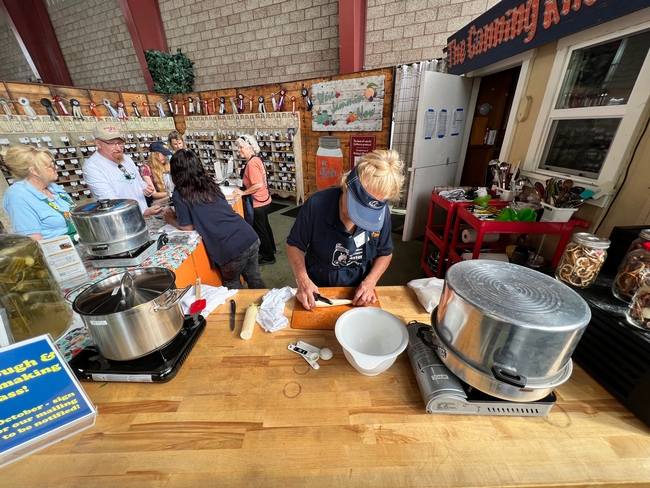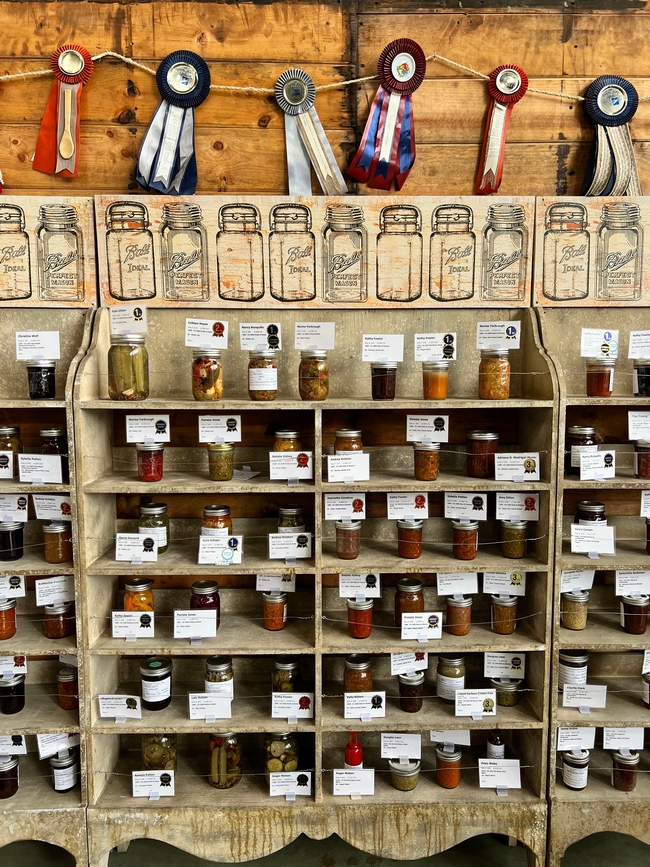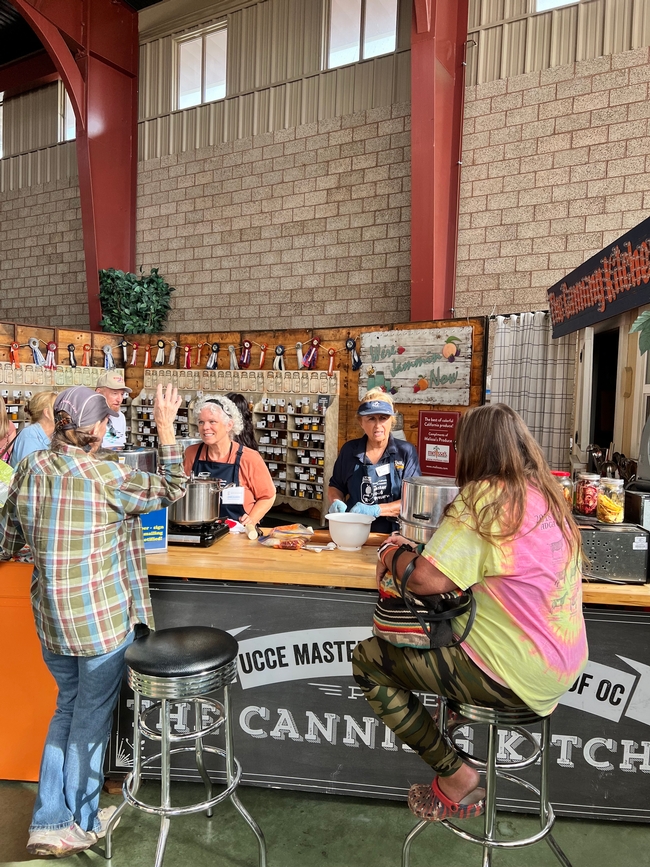Posts Tagged: orange
‘Super Carbolicious’ 4-H Food Fiesta challenges young chefs
Inside a quiet classroom, Sadie, a 4-H member in Orange County, stands in front of two judges with an insulated cooler bag in hand. From it she pulls out plates, utensils and napkins and sets them down on the table. She unzips the bottom compartment and carefully reaches for a cast iron platter with golden fluffy pancakes piled on top.
“Would you like syrup with your pancakes? I highly recommend it,” said Sadie, an eighth grader who is participating in the annual 4-H Food Fiesta for a second time.
4-H, a youth development program supported by the University of California Agriculture and Natural Resources and administered through local UC Cooperative Extension offices, promotes hands-on experiential learning for all youth.
Rita Jakel, 4-H program coordinator for Orange County, described the Food Fiesta event – intended for ages 5 to 18 – as an opportunity to practice and showcase public speaking skills through a fun, food-related competition.
Youth present their creations before a panel of evaluators, who ask them to describe how they prepared the dish and why, and how they managed challenges throughout the process. The interaction between youth and adult leaders provides a unique opportunity for youth to practice career readiness skills such as job interviews and public speaking.
This year's theme was “Super Carbolicious” and 4-H participants were encouraged to make their favorite dishes using ingredients like pasta, potatoes and bread. Carbohydrates are often perceived as unhealthy, which is not a helpful mindset to have when teaching youth about nutrition. Carbohydrates provide the body with glucose, which is converted into energy that people need to function throughout the day.
Some of the dishes that were presented during the Food Fiesta included chocolate chip banana bread, cheesy baked potatoes, cookies and Nutella-stuffed crepes. 4-H member Kaitlin had only ever attended the Food Fiesta to cheer on a friend. This year, she decided to participate and presented pumpkin macaroni and cheese as her entry.
“Pumpkin mac and cheese is better than the regular one because there's a lot more flavor and you have to use two cheeses: cheddar and parmesan,” explained Kaitlin, a seventh grader. When asked what motivated her to participate instead of a being a bystander this time around, Kaitlin said that she wanted to work on her presentation skills.
“Usually, I'm a bit shy and I don't like to share that much. The Food Fiesta helped me practice speaking up more so that I can accomplish my goals,” Kaitlin said.
Sadie, who loves public speaking, admits that it wasn't always a strength of hers. “There was a time when I hated public speaking. But when I joined 4-H's cake decorating, poultry and food fiesta events, I got more comfortable with public speaking,” she said. “Now, I like going to events and showing off. I get to show off turkeys, my cakes and, today, I presented homemade pancakes.”
Helping to keep the day's festivities running smoothly were two 4-H state ambassadors: Michaela and Laurelyn, two high school seniors. Both have been involved in 4-H for over nine years, with Laurelyn being a third-generation 4-H member. “My grandmother grew up in a 4-H club in Orange County. She still raises breeding lambs for 4-H members to this day,” said Laurelyn, whose mother was a 4-H member in San Joaquin County.
As state ambassadors, they are responsible for creating and presenting workshops during state, national and regional events. “We also engage the public via social media, specifically TikTok and Instagram (@4horangeco),” said Michaela, who is in her second year as an ambassador.
During the Food Fiesta, Michaela and Laurelyn made themselves available to answer questions from participants and their families. Both ambassadors agreed that seeing parents involved in 4-H should not come as a surprise. “Being in 4-H is a family effort. This isn't an extra-curricular where you just drop your kids off and leave,” said Michaela.
Laurelyn shared that the biggest misconception others have about 4-H is that they think it's about introducing youth to agriculture or livestock. There's a civic engagement and leadership component to it, too. “If parents knew about all the ways 4-H can benefit their kids, I think more people would want to join us,” she said. “And they're finding fun ways to help us learn life skills, like this Food Fiesta.”
The homemade dishes weren't the only thing to look forward to, however. In another building, Sandy Jacobs, volunteer event coordinator, and her team set up a kitchen quiz for members. On several tables, there were different cooking tools and participants were challenged to name as many tools as they could.
In another classroom, while some members were presenting food, others presented their themed table setting décor. Participants had to prepare a complete table setting entry including a menu card, centerpiece and table settings for two. Judges considered creativity, use of color, table setting etiquette, knowledge in talking to the judges, and appearance in their evaluation.
Finally, to wrap up the day, members competed in a cupcake decorating competition. Participants were responsible for bringing their own supplies including tools and edible decorations for Cupcake Wars. Depending on their age group, participants had 20 minutes to decorate two to four cupcakes, each of a different theme.
To learn more about 4-H in Orange County, visit https://oc4h.org/.
New avocado proves tasty, safer to harvest at UC ANR Research and Extension Centers
A new avocado, one that complements the widely known ‘Hass,' will hit the world market soon. The ‘Luna UCR' variety (trademarked and patent pending) has several characteristics that should be of interest to both growers and consumers, said Mary Lu Arpaia, University of California Cooperative Extension subtropical horticulture specialist based at UC Riverside.
From the grower perspective, the tree is about half the size of the leading variety while producing approximately the same yield per tree as ‘Hass,' meaning that growers could plant more trees per acre, therefore increasing yield. It also makes harvesting easier and safer.
Another advantage is the flowering behavior of the tree. Avocado trees are categorized into either Type A or Type B flower types. It is generally accepted that you need both flower types in a planting to maximize productivity. The ‘Hass' is an “A” flower type and ‘Luna UCR' is a Type “B.”
This is a potential boost for growers since the current varieties that are “B” flower types ripen green and generally receive lower prices for the grower. Similar to ‘Hass,' however, the ‘Luna UCR' colors as it ripens.
“Hopefully, it will receive similar returns to the ‘Hass' once it is an established variety,” Arpaia added.
Fruit breeding is a long-term process that she has navigated by building upon the work of her predecessors. Of course, Arpaia has had strong support from colleagues as well, including Eric Focht, a UC Riverside staff researcher and co-inventor of ‘Luna UCR.'
“We had been looking at ‘Luna UCR' for some time and it was always a very good eating fruit,” Focht said. “After the 2003 release of ‘GEM' (registered and patented as ‘3-29-5', 2003) and ‘Harvest' (patented as ‘N4(-)5', 2003) varieties, ‘Luna UCR' was always the top contender for a next release due to the small, narrow growth habit, “B” flower type and the fruit quality.”
“It's a very nice-looking fruit as well and seemed to be a pretty consistent bearer from year to year.”
A glimpse at how it all started
In spring 1996, Arpaia took over the UC Avocado Breeding Program following Guy Witney who led the program from 1992 to 1995, and Bob Bergh whose initial efforts in the 1950s were foundational in the inception of ‘Luna UCR.'
Arpaia recalls the first trials in the early 2000s of ‘Luna UCR,' which were tested alongside other promising selections from the Bergh program. “There were a lot of varieties that didn't perform well, some of which had poor storage life, an important trait that we need if we are going to get the fruit to consumers across the country,” said Arpaia.
The original seed and selection were planted at the Bob Lamb Ranch in Camarillo, and originally advanced trials of the ‘Luna UCR' variety were planted in four locations: UC Lindcove Research and Extension Center in Tulare County, UC South Coast Research and Extension Center in Orange County, a privately owned farm in San Diego County and another one in Ventura County.
The RECs are among the nine hubs operated by UC Agriculture and Natural Resources to support research and educate the public on regional agricultural and natural resource challenges.
ANR Research and Extension Centers become vital
Unfortunately, the 2017 Thomas Fire burned the avocado trees in Ventura, said Arpaia. After a change in management, the trial located in San Diego County was also terminated, leaving the two trials at Lindcove and South Coast REC.
“South Coast REC has a long history of supporting research and extension activities of high value crops important to California, including avocados,” said Darren Haver, director of the South Coast REC, which was often used to show growers the new varieties that were being developed.
“Many of the REC staff have worked with the avocado-breeding program researchers for more than two decades and continue to work closely with them to ensure the success of new avocado varieties, including ‘Luna UCR',” he added.
In addition to the support provided by South Coast and Lindcove RECs, Arpaia said that UC Kearney Agricultural Research and Extension Center in Fresno County – another UC ANR facility – made it possible for her team to conduct critical postharvest and sensory research, and consumer testing of the fruit, which included up to six-week trials of fruit ratings for storage life and taste.
“UC ANR has played an important role in our ability to not only identify ‘Luna UCR', but in preparing it for the world market, too,” she said.
Preparing to share with the world
Since 2015, Focht had been collecting data for the patent application. Now that he and Arpaia have successfully patented and trademarked ‘Luna UCR,' they are preparing to expand production by engaging interested growers with the commercial partner, Green Motion who is based in Spain.
“Green Motion contracted for 1,000 trees to be generated by Brokaw Nursery and those trees are currently being distributed, with earliest field plantings likely taking place in fall,” explained Focht.
Focht also said that Mission Produce, based in Oxnard, CA has contracted to graft over a small number of “B” flower type pollinizer trees to the new ‘Luna UCR' variety, possibly making way for a small number of avocados to be available the following year.
Once planted, the avocado trees will come into “full” production in about five years.
To read this story in Spanish, visit: https://ucanr.edu/blogs/blogcore/postdetail.cfm?postnum=58991
Master Gardeners create garden-to-table experience for adults with disabilities
Along Pacific Coast Highway in Laguna Beach, atop a small hill, sits a residential community for adults with disabilities. When you get past the gate to Glennwood Houseand look beyond the parking lot, you'll immediately notice the quaint oasis of swinging benches enclosed by vegetables growing in large pots and along walkways.
The garden, which is maintained by the residents, was created in spring 2022 by Monica Mehren Thompson and Robbie Prepas, two UC Master Gardener volunteers of Orange County.
The UC Master Gardeners program is a public service and outreach program of University of California Agriculture and Natural Resources. Through the efforts of more than 6,000 Master Gardener volunteers across the state, the program is a unique driving force of change in local communities.
Thompson and Prepas completed their 16-week Master Gardener training in 2021 and quickly turned to Glennwood House for an opportunity to apply their newly acquired skills. Troy, Thompson's son, was a resident at Glennwood for nine years, making her decision to develop a garden on the grounds an obvious choice.
“This place is truly magical,” said Thompson.
Prepas agreed and shared that the residents play an active role from beginning to end. “We take the residents with us when we buy seeds so that they can choose what they want to grow,” she explained.
The garden has only experienced two plantings so far: spring and fall 2022. When it's time to harvest, the residents eagerly gather to taste the fresh vegetables and herbs. During the week, dinners are prepared by a professional chef, who incorporates ingredients pulled from the garden.
This will soon change, however. Since the residents enjoy the hands-on opportunity to cook so much, they'll now be in charge of preparing lunch and dinner every Friday. To kick start this shift, the residents prepared a huge salad and spaghetti with vegetable marinara sauce. The meal was a big hit and the residents were so proud of their creation.
“This is an all-out, very sophisticated effort with the Master Gardeners,” said Faith Manners, Glennwood House CEO.
Glennwood House is unlike other residential communities for persons with special needs in that it is home to 46 residents. “It's one of the largest supported-living communities in the U.S.,” Manners said, adding that Glennwood has an enormous waiting list.
According to Janet Parsons, development and facility director at Glennwood House, Laguna Beach genuinely embraces Glennwood residents. “When we're out and about, you should just see how warm and welcoming the community is towards our residents. Everyone is always engaging and smiling,” she shared.
Recently, the Laguna Beach Garden Club caught wind of the community garden at Glennwood and made a $1,500 donation to help fund materials.
Janet Chance, president of the Garden Club, credited Glennwood as one of the few places that caters to adults living with disabilities, commending their ability to cultivate a sense of belonging and integrate them into the greater Laguna Beach community.
While Chance regrets not having the time to become a Master Gardener herself, she attends some of the classes they teach in the Laguna Beach community. “The work they do is remarkable,” she said, adding that the club's recent donation was “one of the best” they have ever made.
Parsons said that it's important for the residents to feel independent. Therefore, the administration and the staff prioritize intentional programming. For example, instead of simple activities like coloring, Glennwood hosts advanced art sessions so that interested residents are learning techniques that will strengthen their artistic capabilities.
The same idea applies to the “farm-to-table” experience Thompson and Prepas have established.
“Just because the residents are living with a cognitive disability, it doesn't mean they're incapable of learning new things,” Parsons said. “They will tell you when something is boring or when they're not interested. So, we try to select activities or programs based on skills, personal interests and goals.”
While being recognized for the positive effect the gardeners have on the residents, Prepas quickly interjected that the real positive effect is the one that residents have on her. “I've learned so much from them,” she said. “They're incredible and so much fun to be around.”
Thompson, whose son lived at Glennwood until he passed away earlier this year, describes the Glennwood community as her family. Seeing Thompson's delight while gardening or cooking with the residents, it's easy to understand what she means.
“My husband has always supported philanthropy,” said Thompson. “But he says this feels like so much more than that. Because it is!”
To learn more about the UC Master Gardener program visit https://mg.ucanr.edu/.
South Coast REC supports school-to-work pipeline for students with disabilities
Before Brent Flory, 22, started bagging fruits and vegetables at his local Stater Bros. Market, he picked them at the University of California South Coast Research and Extension Center in Irvine.
In partnership with Saddleback Unified School District's Esperanza Education Center, an adult transition program that provides independent living and life skills training for students with disabilities, South Coast REC hosts students on its 200 acres of land and introduces them to careers in agriculture.
Flory recalls picking avocados as one of his favorite moments from the program at South Coast, one of nine RECs across California operated by UC Agriculture and Natural Resources. “I picked a huge avocado and got to bring it home. It was the size of a medium pumpkin,” he shared.
Field work doesn't warrant business attire, but Flory said that working at South Coast REC taught him the importance of dressing appropriately for work. In this case, it meant pants, closed-toe shoes, a shirt with sleeves, and sunscreen or a hat if working in the sun.
While program managers hope that participating students would pursue a career in agriculture, South Coast REC is more concerned about providing opportunities for students to gain real work experience in a unique setting.
“This is the first time I have had the opportunity for my students to work at a job site in the agricultural field. We never really thought of the agricultural industry as an option for our students,” said Esperanza's education specialist, Michael Seyler.
Esperanza's partnership with South Coast REC began in October 2019. Since then, nine participants have been assigned to work at the research center where they help create seedlings, plant and harvest crops, and learn plant management.
Ray Bueche, Adult Transition Program coordinator and Career Start administrator at Esperanza, is proud of the creative energy it took to develop the program and unite partners, crediting Jason Suppes, South Coast REC's community education specialist. “Working with Jason and UC ANR has inspired me to continue to reach for unique partnerships in this field and elsewhere,” Bueche said.
Dylan Shelden, 19, another past participant, said that the program revealed how important it is for him to choose a career that makes him feel happy and independent. “You are responsible for yourself,” he said. “So, don't quit on the first try.”
Shelden currently works at Party City as a store organizer. Even though he prefers working indoors, Shelden described working with plants and being outdoors as refreshing. “Working in agriculture makes me feel good,” he said.
When asked what advice he would give incoming students, Shelden said: “Be kind, mindful, and thoughtful to others.”
“Things are constantly changing at the farm and follow seasonal patterns. Students get to work with different types of produce depending on the season. So many of my students only thought about jobs in retail or food services industries,” said Seyler. “This has opened their eyes to other possibilities.”
The soft skills learned while working at South Coast REC has helped other students secure paid competitive employment during or following the program. It has also inspired program staff like Bueche and Seyler to consider other unique opportunities for their students to connect the skills they have learned on the farm to other types of jobs.
To learn more about the Adult Transition Program at Esperanza Education Center, visit: https://www.svusd.org/schools/alternative-schools/esperanza/about/why-esperanza
More than a TikTok trend, preservation is the future of food
UC Master Food Preservers give live canning demonstrations at Orange County Fair
If you visited the Orange County Fair in Costa Mesa during the past month, you might have seen the Master Food Preservers of Orange County in their rustic farmhouse-themed kitchen located in the OC Promenade exhibit hall.
If the decor did not catch your eye, the colorful rows of glass jars lined along the walls certainly would have. For an entire month, three volunteers conducted live canning demonstrations from 11 a.m. to 8 p.m. five days a week. They are with the UC Master Food Preserver Program, a public service and outreach program under UC Agriculture and Natural Resources.
The OC Fair is UC Master Food Preserver's largest event in Orange County. Last year, the UC Master Food Preservers engaged 7,000 people at their booth.
For over 30 years, the UC Master Food Preserver program has trained hundreds of volunteers statewide to keep Californians safe as they use culturally appropriate and research-based practices to preserve food in the home and provide engaging ways to explore healthy food.
Food preservation has a deep history rooted in human survival. Whether freezing, drying, fermenting or pickling, preservation is a practice that has prolonged the life of food and humans. Other benefits include reducing food waste and increasing food security.
The latest form of preservation, called canning, was introduced in the early 1800s according to a Smithsonian article. By placing food in a glass jar and heating it to a certain temperature for a prescribed period of time, oxygen is removed and a vacuum is created. This process prevents the growth of undesirable bacteria, yeasts and molds, thus keeping the food from spoiling.
This is what you would have found the UC Master Food Preservers demonstrating at the OC Fair.
During her shift, Flo Vallejo, UC Master Food Preserver since 2018, carefully chopped carrots and daikon into thin slices and placed them inside small mason jars with spices inspired by Vietnamese cuisine.
Between the produce donated by Melissa's Produce and the diverse spices donated by Tampico Spice, the possibilities of what you will see the UC Master Food Preservers canning are endless.
“This is something my great-grandmother, grandmother and mother did. I never understood it because they didn't let the little kids in the kitchen,” said first-year UC Master Food Preserver Alice Houseworth.
Many of the UC Master Food Preservers have some experience with canning, whether it be a practice passed down from generation to generation, or, in Houseworth's case, something they watched their elders do as a child.
Some might view canning as a hobby, but according to the UC Master Food Preservers, food preservation is an opportunity to prepare for economic and climatic change.
Esa Kiefer, another UC Master Food Preserver since 2018, expressed her concern for the rising prices of food and decline in arable land. “I feel like now is the time to prepare for these changing times,” she said. “Who knows what the future will look like for food?”
Perhaps the future of food will come from glass jars.
“You can even can chicken,” Houseworth said. “When it's cheap at the grocery store, you can buy it and use the pressure canner and then eat it when chicken prices go up.”
Vallejo recalls when pickling and canning were trending on social media during the stay-at-home phase of the COVID-19 pandemic, making it difficult to find mason jars.
“Preservation has been done for a long time. When I saw a lot of people doing it during the pandemic, I thought it was just because people had time on their hands. But I realized that many became concerned about the food supply and accessibility,” she explained.
The resurgence in food preservation interest makes the work of the UC Master Food Preserver program much more essential. Whether you are feeding a large family, living in a food desert or managing a tight budget, food preservation ensures you are fed today, tomorrow and beyond.
To learn more about the Master Food Preserver Program or to locate the nearest program in your area, visit: https://mfp.ucanr.edu/.

